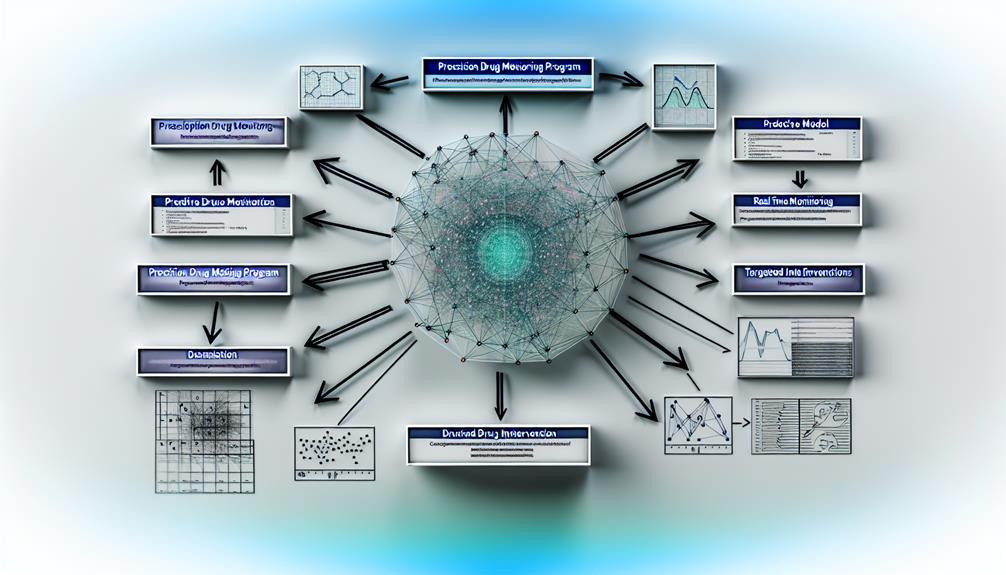Are you looking to enhance your understanding of prescription drug monitoring programs? Interested in discovering how data analytics can play a crucial role in effectively managing and preventing prescription drug abuse?
Look no further. In this discussion, we will explore the importance of prescription drug monitoring programs and how mastering data analytics can help uncover key insights and drive evidence-based strategies.
By leveraging the power of data, you can gain a deeper understanding of prescription drug abuse trends and implement targeted interventions to combat this growing issue.
So, let's dive into the world of data analytics and its impact on prescription drug monitoring programs.
Understanding Prescription Drug Abuse

To better understand prescription drug abuse, analyze the data collected from prescription drug monitoring programs. These programs play a crucial role in combating the opioid crisis by monitoring the prescribing and dispensing of controlled substances. One key aspect of prescription drug abuse is doctor shopping, which refers to individuals seeking multiple prescriptions from different doctors without their knowledge. By analyzing the data, we can identify patterns and trends in doctor shopping, enabling us to take proactive measures to prevent it.
Data from prescription drug monitoring programs can provide valuable insights into the extent of the problem. It can help us identify individuals who are obtaining prescriptions from multiple doctors, allowing us to intervene and provide appropriate interventions. Additionally, analyzing the data can help us identify healthcare providers who may be overprescribing or enabling doctor shopping. This information can be used to implement targeted education and training programs to ensure appropriate prescribing practices.
Furthermore, data analytics can help us track the movement of prescription drugs, identifying areas with high rates of abuse and enabling law enforcement agencies to focus their efforts on those regions. By understanding the patterns and trends related to prescription drug abuse, we can develop effective strategies to combat this crisis and protect public health.
Importance of Prescription Drug Monitoring Programs
Prescription drug monitoring programs play a vital role in combating the opioid crisis by collecting and analyzing data on the prescribing and dispensing of controlled substances. These programs have a significant impact on healthcare costs by helping to identify and prevent prescription drug abuse.
By monitoring the prescribing patterns of healthcare providers, these programs can detect excessive or inappropriate prescribing practices, leading to interventions that promote safer prescribing habits. This, in turn, helps to reduce the misuse and overuse of opioids, ultimately lowering healthcare costs associated with opioid-related healthcare services.
Moreover, prescription drug monitoring programs have been effective in reducing opioid overdose deaths. By analyzing data on prescription drug use, these programs can identify individuals who may be at high risk of overdose and connect them with appropriate interventions, such as addiction treatment or overdose prevention programs.
Additionally, these programs can help healthcare providers identify patients who may be engaging in 'doctor shopping' or obtaining multiple prescriptions from different providers, allowing for early intervention and prevention of potential overdose cases.
Role of Data Analytics in Prescription Drug Monitoring

By harnessing the power of data analytics, prescription drug monitoring programs can leverage the information collected on prescribing and dispensing practices to drive evidence-based interventions and improve patient safety. Data analytics plays a crucial role in these programs by providing valuable insights and actionable intelligence.
Here are three key ways in which data analytics contributes to the effectiveness of prescription drug monitoring:
- Identifying patterns and trends: Data analytics allows for the identification of patterns and trends in prescription drug use, such as high-risk prescribing practices or excessive opioid prescriptions. By analyzing large datasets, monitoring programs can proactively detect potential issues and intervene early to prevent harm.
- Detecting doctor shopping and fraud: Through advanced analytics techniques, prescription drug monitoring programs can detect suspicious patterns of behavior, such as patients obtaining multiple prescriptions from different doctors or pharmacies. By flagging these instances, programs can help identify potential cases of doctor shopping and prescription fraud.
- Supporting public health initiatives: Data analytics enables monitoring programs to generate reports and dashboards that provide valuable information to healthcare providers, policymakers, and law enforcement agencies. These insights can inform public health initiatives, such as targeted interventions, educational campaigns, or policy changes, to address the opioid crisis and improve patient outcomes.
Key Metrics for Effective Data Analysis
Effective data analysis in prescription drug monitoring programs relies on key metrics that provide valuable insights and inform evidence-based interventions.
To conduct a comprehensive analysis, it's essential to employ data visualization techniques and predictive modeling.
Data visualization techniques enable you to transform complex data sets into intuitive visual representations, making it easier to identify patterns, trends, and anomalies. By using charts, graphs, and maps, you can quickly grasp the overall picture of prescription drug utilization and identify areas that require further investigation.
Predictive modeling, on the other hand, allows you to forecast future trends based on historical data. By analyzing patterns and relationships within the data, predictive models can predict the likelihood of certain outcomes, such as the possibility of overdose or the potential for diversion. These models provide proactive insights that can guide decision-making and enable timely interventions to prevent or mitigate potential risks.
When selecting key metrics for effective data analysis in prescription drug monitoring programs, it's important to consider the specific goals and objectives of the program. Metrics such as prescription rates, drug utilization patterns, and geographic distribution of drug prescriptions can provide valuable insights into the prevalence and impact of prescription drug misuse.
Additionally, metrics related to patient demographics, such as age, gender, and medical history, can help identify populations at higher risk and inform targeted interventions.
Implementing Data-driven Strategies for Prevention and Intervention

To implement effective prevention and intervention strategies, harness the power of data-driven insights and analytics. By using data to inform your decision-making process, you can identify patterns and trends that will help you develop targeted interventions and prevent prescription drug abuse.
Here are three ways you can leverage data to drive your prevention and intervention efforts:
- Analyze prescription patterns: Use data analytics to examine prescription patterns and identify any irregularities or outliers. By understanding the prescribing habits of healthcare providers, you can identify potential areas of concern and take appropriate action.
- Monitor patient behavior: Utilize data from prescription drug monitoring programs to track patient behavior. Identify individuals who may be doctor shopping or obtaining multiple prescriptions from different providers. This data can help you intervene early and prevent misuse or abuse.
- Collaborate with stakeholders: Share data with healthcare providers, law enforcement agencies, and other relevant stakeholders. By working together and sharing information, you can create a comprehensive approach to prevention and intervention. Data-driven collaboration allows for a more holistic understanding and response to the issue.








